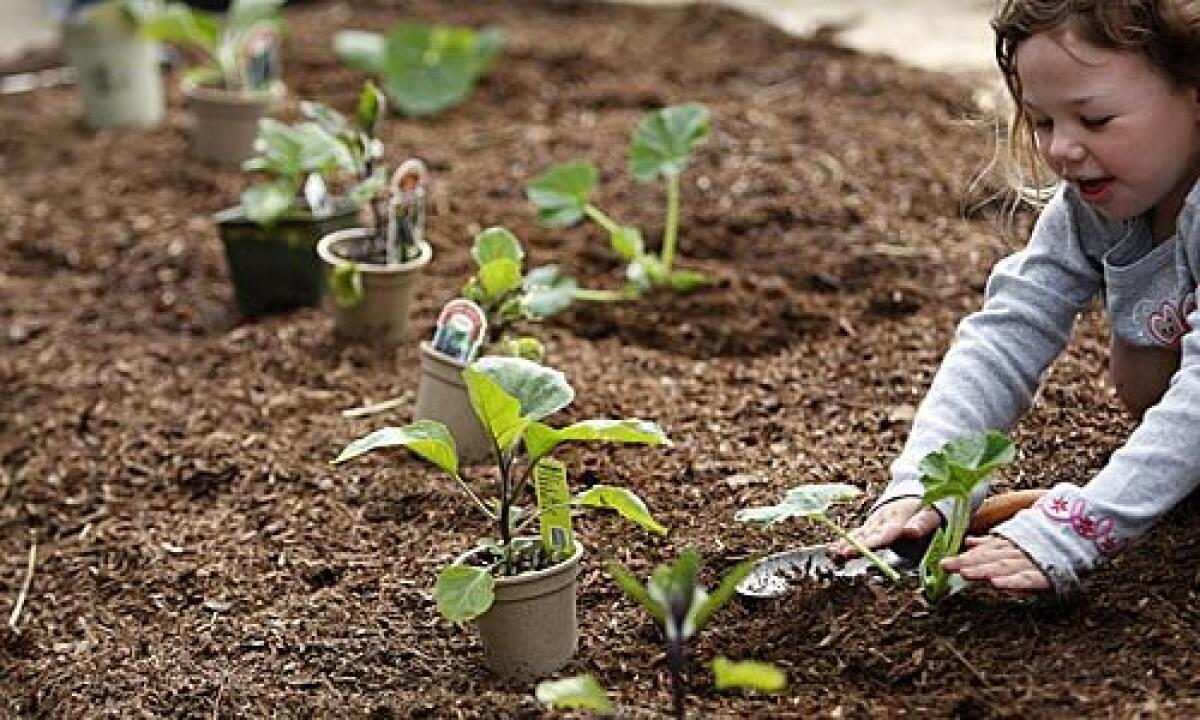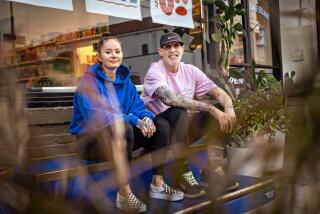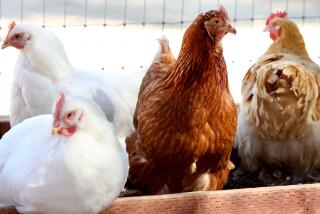Tackling the ethics of eating

There was a time, not so long ago, when eating in an environmentally, ethically conscious way was a drab business -- brown and beige food, with a few wilted organic vegetables relegated to a woebegone produce bin at the grocery store.
But these days, everything is coming up green and, forgive us, groovy. Buying delicious, locally and humanely raised food is the new righteous way to save your health and your planet. Wal-Mart shoppers can buy organic food, and the first family is planting vegetables on the first lawn.
Since January, there’s even been a green convenience store in Hollywood called Locali, stocked with items such as grass-fed beef hot dogs from Let’s Be Frank. The slushy is “ginger tonic,” and the ice cream comes from Carmela. Store owners Melissa Rosen and Greg Horos give away filtered water to their customers and sell canvas bags decorated by the students at a nearby elementary school.
“It’s not like we all have to hold hands and sing ‘Kumbaya’ together,” Rosen says, but she and Horos made “a deliberate choice to do better” with their business.
But as sustainable living turns chic, the choices for living the simple life become anything but. Should you wash your dishes by hand, or does the dishwasher use less water? Drive to the farmers market or save gas and make do with what’s in the closest supermarket? Must you become a vegetarian?
“It’s been a long process for me,” says D.J. Olsen, chef at Lou wine bar, who adds that he started buying organic food in Minnesota in the 1970s, in the days of Frances Moore Lappé’s bestseller “Diet for a Small Planet.” The food, he says, “was awful.”
Now, he says, he buys organic produce in part because it tastes best, and when he pays a premium for meat from a ranch that raises its animals humanely, he’s getting meat that he’s happy to serve.
Caterer Rachael Narins grew up with a dad who washed and reused foil, and she spent Thanksgivings on Long Island, where the turkey, vegetables and preserves all came from their neighbors.
“In my ideal world, you don’t have to seek out ethical food, because it’s all ethical,” she says one morning over breakfast at a cafe.
The business she and a partner run, Chicks With Knives, describes itself as “S.O.L.E.,” for sustainable, organic, local and ethical. When they cook in people’s homes, they try to use produce from the client’s yard. And they organize suppers with talks about the meal, occasionally including a farmer. Everything is up for consideration.
“I mean, look at this lemon slice,” Narins says as she points to her glass of iced tea. “There’s a whole [production] chain that goes along with that slice that’s sitting on my glass and will get thrown out.”
Alice Waters, the chef-owner of Chez Panisse in Berkeley and an early proponent of eating locally and seasonally, says there is now a critical mass of people thinking about the ethics of their food choices.
“I think it’s the force of young people who have been educated,” she says. “They just believe it’s the right thing to do.”
Words to live by
From belief to practice, however, may take some guidance. Fear not, there are plenty of books to turn to for advice this Earth Day. While Michael Pollan -- perhaps especially in his 2006 book “The Omnivore’s Dilemma” -- inspired a lot of the current conversation about what to eat, where it comes from and how it gets to the table, several authors are addressing “sustainable” eating, a concept that has moved from the fringe to the mainstream.
Is it OK to buy that organic peach in January if it comes from Chile, or is the fuel used to transport it too costly to the planet? What about the lives of the animals killed for food? Or those of the people who work in slaughterhouses or pick strawberries? When words like “sustainable” are marketing tools, how can a consumer figure out what to do? And can a family on a budget afford to eat sustainably?
“We feel so out of control of everything that’s around us,” says Kate Heyhoe, author of the book “Cooking Green.” “Being green is something we can impact.”
Heyhoe, and Mark Bittman, in his book “Food Matters,” offer practical advice about shopping and cooking for human health and the health of the planet.
Heyhoe urges readers to reduce their environmental impact, what she calls a “cookprint,” by such efforts as more efficiently using appliances, which account for 30% of household energy use. She also provides lots of little tips -- which materials work best for cutting boards, how to thaw foods efficiently, how much energy various grills use. Just about every cooking process gets assessed.
In “Cool Cuisine,” Laura Stec, with Eugene Cordero, covers some of the same turf, with lots of charts and explanations about global warming and agriculture, plus recipes and short profiles of some innovative people and companies, including Coskata, which turns trash into fuel. If you’re inclined to bring your own bags to the store but often forget to actually do so, they have a good “small things matter” idea: Get markets to post reminder signs in the parking lots.
Bittman advocates a “sane eating” approach that calls for plates piled high with fruits and vegetables, but with only sparing amounts of snack foods and meat. By following his own advice, says the author of the popular traditional cookbook “How to Cook Everything,” he lost weight and reduced his blood sugar and cholesterol.
Easy on the steak
The authors of all three books encourage their readers to cut down on meat (Bittman says to eat only about a pound a week), and they suggest ways to eat cheaply and healthfully.
“Eating a typical family-of-four steak dinner is the rough equivalent, energy-wise, of driving around in an SUV for three hours while leaving all the lights on at home,” Bittman writes. So to feed six people, his grilled kebabs call for 2 pounds of vegetables and 1 pound of meat or fish, and his cassoulet has just a pound of meat.
Nothing encapsulates the difficulty of our current food choices more than fish. Fish can be a nutritional bonanza. But figuring out which fish to eat could make people tear their hair out.
As Heyhoe says, it “opens up the biggest can of worms.” And in his new book, “Bottomfeeder,” Taras Grescoe digs through that can thoroughly.
Grescoe’s entertaining and enlightening worldwide tour, from the fish-and-chips shops of England to extravagant seafood dinners in China, can leave readers feeling that even buying fish for dinner requires a PhD to avoid mercury or keep from contributing to over-fishing, pollution or mislabeling.
Fortunately, Grescoe includes a listing of what to eat among other resources such as the Monterey Bay Aquarium seafood guide.
Consider another set of issues in Mark Caro’s “The Foie Gras Wars.” Though few of the combatants might call their experience “fun,” reading this book is plenty of it -- as well as being a look into one of the most impassioned of ethical food fights.
Caro takes off from Chicago chef Charlie Trotter’s decision in 2002 to stop cooking the fatty duck (or goose) livers in his restaurant and tells a tale brimming with venom and moralizing and lawsuits. Governments (including California’s, starting in 2012 vote to ban it). Chefs snipe at each other, protesters get arrested, all over an expensive food that few companies produce and many people never eat. For a time, after Chicago authorities banned the sale of foie gras, fans got their fix at “quackeasies.”
If all this information inspires a desire for blissful ignorance and a Birkenstock ban -- calm down with a “green” foot scrub with organic turbinado sugar and tea tree oil -- there’s another option.
A blond pin-up girl, who’s sitting on top of the world -- dressed in sexy green, of course -- looks out from the cover of Sophie Uliano’s new book, “The Gorgeously Green Diet.” Uliano, herself a pretty blond wearing a green sweater in her book jacket photo, holds out the promise of saving money, looking great and going green -- with three entry points, depending on your level of commitment: “Light Green,” “Bright Green” and “Deep Green,” each with a shopping list and eating plan.
She encourages readers to garden and compost, work out, make their own yogurt and bread and buy in bulk. Like other writers, Uliano gives her readers a gentle nudge, asking not for revolutionary changes, but rather for “small, everyday steps that make sense for your busy and budget-challenged lives.”
It’s not all work and no play: Her recipes include a flourless chocolate cake and a version of crème brûlée.
And if you’re wondering how a “fully nontoxic, organic girl” can emulate that pin-up, Uliano has some answers: “ecolicious” recipes for a “bananarama” face mask and an almond and yogurt hair treatment.
More to Read
Eat your way across L.A.
Get our weekly Tasting Notes newsletter for reviews, news and more.
You may occasionally receive promotional content from the Los Angeles Times.







